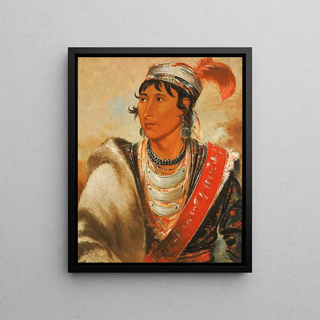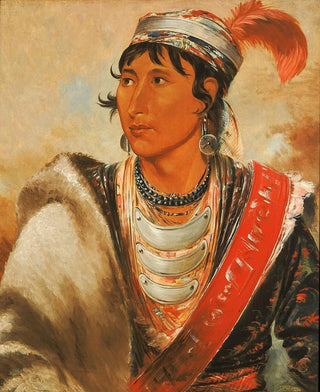Art print | Lhshee the Licker called Creek Billy - George Catlin


View from behind

Frame (optional)
Art print of Lhshee the Licker called Creek Billy - George Catlin – Engaging Introduction
In the vast panorama of American art history, the work "Lhshee the Licker called Creek Billy" by George Catlin stands out for its authenticity and depth. Capturing a fleeting moment in Native American life, this painting immerses us in the traditions and rituals of a often little-known culture. Catlin, as a privileged witness of his time, offers us a window into a changing world, where every detail is imbued with profound meaning. The art print of this iconic piece allows us to appreciate not only the technical virtuosity of the artist but also the historical richness it embodies.
Style and uniqueness of the work
Catlin's work is characterized by a distinctive style that combines realism and romanticism. Vibrant colors and dynamic compositions animate the scenes he depicts, bringing characters and their environments to life. In "Lhshee the Licker called Creek Billy," the artist uses a rich palette to pay tribute to the beauty of traditional costumes and the complexity of human expressions. Each brushstroke seems to tell a story, evoking both the strength and vulnerability of the subjects. This painting does not merely depict an individual; it captures the essence of a culture, a way of life, and a deep connection to the land and nature.
The artist and his influence
George Catlin, born in 1796, is often considered one of the first artists to document the indigenous peoples of North America. His commitment to preserving their cultural heritage is remarkable, especially at a time when these traditions were threatened by colonial expansion. Catlin traveled across the continent, collecting portraits, stories, and art objects, aiming to raise public awareness of the richness of Native American cultures. His work has had a lasting impact on the perception of these peoples and paved the way for a deeper appreciation of their history. By rediscovering works like "Lhshee the Licker called Creek Billy," we honor not only the artist but also the cultures he sought to immortalize.
A decoration

Matte finish

View from behind

Frame (optional)
Art print of Lhshee the Licker called Creek Billy - George Catlin – Engaging Introduction
In the vast panorama of American art history, the work "Lhshee the Licker called Creek Billy" by George Catlin stands out for its authenticity and depth. Capturing a fleeting moment in Native American life, this painting immerses us in the traditions and rituals of a often little-known culture. Catlin, as a privileged witness of his time, offers us a window into a changing world, where every detail is imbued with profound meaning. The art print of this iconic piece allows us to appreciate not only the technical virtuosity of the artist but also the historical richness it embodies.
Style and uniqueness of the work
Catlin's work is characterized by a distinctive style that combines realism and romanticism. Vibrant colors and dynamic compositions animate the scenes he depicts, bringing characters and their environments to life. In "Lhshee the Licker called Creek Billy," the artist uses a rich palette to pay tribute to the beauty of traditional costumes and the complexity of human expressions. Each brushstroke seems to tell a story, evoking both the strength and vulnerability of the subjects. This painting does not merely depict an individual; it captures the essence of a culture, a way of life, and a deep connection to the land and nature.
The artist and his influence
George Catlin, born in 1796, is often considered one of the first artists to document the indigenous peoples of North America. His commitment to preserving their cultural heritage is remarkable, especially at a time when these traditions were threatened by colonial expansion. Catlin traveled across the continent, collecting portraits, stories, and art objects, aiming to raise public awareness of the richness of Native American cultures. His work has had a lasting impact on the perception of these peoples and paved the way for a deeper appreciation of their history. By rediscovering works like "Lhshee the Licker called Creek Billy," we honor not only the artist but also the cultures he sought to immortalize.
A decoration






